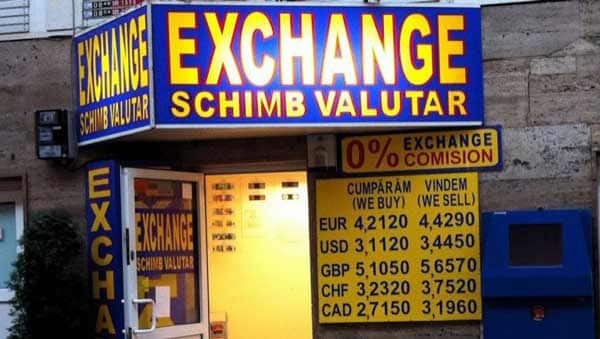




Now that you are in Romania you will need to use the local currency: the LEU.
Even though Romania is a member state of the European Union, it is not part of the Eurozone.
This means that in cash you will need to pay in the Romanian currency almost anywhere you go.
Very few places – some restaurants and souvenir shops in the Old Town of Bucharest – take Euro.
But, have no fear, it is incredibly easy, safe and affordable to change money in Romania.

You can do this at: banks or exchange offices and there is no shortage of these in the center of Bucharest.
None charge any commission, butt you will find the best rates at exchange offices, where the procedure is much quicker than at banks – it takes less than 2-3 minutes. Please note that you may be asked to present a document in order to exchange money.
There is also the possibility to simply withdraw money from the ATMs or pay with a credit card.
You can do the latter almost at all important vendors: supermarket chains, restaurants, cafes, shops, metro, but not everywhere.
In Romania, people are predominantly paying in cash, so it’s difficult to get by only with the use of a credit card.
Don’t forget that both the ATM and POS devices will require you to enter your PIN number.
Those with an American Express card might have some difficulty finding the right ATM or paying with their card.
So it’s best to carry some cash when arriving in Romania (Dollars or any other major currency) in order to exchange it here.

All banks and exchange offices will change Euro, Dollars or Pounds into Romanian Lei.
However only banknotes are accepted, no coins and sometimes they can refuse very used or torn notes.
You can find the current exchange rates here: http://www.cursvalutar.ro/
As you are changing money, you will notice that the abbreviation for the Romanian currency is RON.
This will be something you will read frequently on the tags in stores or the restaurant menus.
Just remember that RON or Leu or Lei is the same thing: Romanian money.
As soon as you’ve changed the money and held the notes in your hand you will realize that there is something different about them.
This is because all the notes are made of plastic, so they are shiny and much more resistant.
Besides this, they can be an interesting souvenir, especially if you like collecting foreign money.
